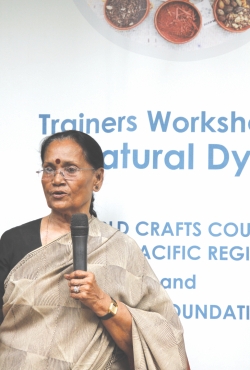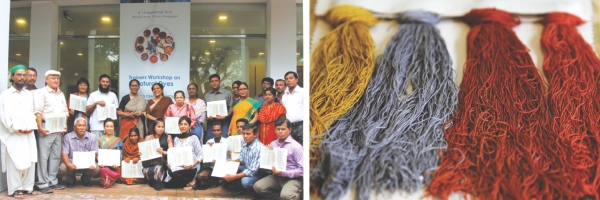| Home - Back Issues - The Team - Contact Us |
 |
| Volume 11 |Issue 37| September 21, 2012 | |
|
|
Heritage Dyeing to Stick Around Soraya Auer
Creating intricate and exquisite handmade crafts from natural ingredients is considered a dying art as countless young people overlook it for modern professions that didn't even exist a generation ago. This, however, has not stopped passionate and experienced artisans in the Asia Pacific region from sharing their knowledge among one another, in the hopes that working together will increase global interest in their craft's survival. World Crafts Council (WCC) Asia Pacific and Bengal Foundation hosted a workshop last week in Dhaka for an international delegation as part of WCC's Natural Dye Programme. The Training of Trainers Workshop is the first of its kind, with experts sharing dyeing techniques from their respective countries in the hope that reviving organic dyes will allow it to replace chemical dyes commonly used across the world. “This programme is for the people who have learnt to go back and teach others in their countries so that we will have a core group of trainers,” explains Ruby Ghuznavi, President of National Crafts Council of Bangladesh and former managing director of Aranya. “Within our region, we are trying to share the expertise so that more and more people will produce it as the market is there. Normally the market is the problem but we have the demand, we just can't push the supply until we have more producers. “There are some countries like Oman who don't use these crafts at all but they have come as an observer so they may ask any of us to come and teach them.” She concludes, “So the whole purpose is for the transfer of technology.” During the seven day workshop, Master Craftsmen from Thailand, Nepal, Laos, Malaysia, India, Pakistan, Bhutan and Bangladesh demonstrated dyeing techniques of 12 basic colours from natural resources, which singly or as a combination of colours create a wide repertoire of shades. Some of the ingredients used included leaves, flowers, plants, bark and waste materials. While madder, indigo and stick lac are expensive, waste materials like onion skins and jack wood saw dust are not. Konthong Nanthavongdouangsy Saisanith, an award-winning craftswoman from Laos, explains some of the laborious techniques she shared with international colleagues. “We use different types of materials, so like jack wood, we have to soak for two hours and then boil for six hours so that a rich colour comes out in the water. It needs a lot of time.” There were also colour fast natural ingredients such as tea waste, presented by the Indian delegation, which can produce different shades of brown. “What we're trying to do at the moment in Bangladesh is standardise the colours,” says Ghuznavi. “Many other countries are too, so that when you get an export order or even a domestic order you can repeat it. The idea is to standardise it to make it cost effective.” Natural dye materials, much like all organic products, have become increasingly popular not only for the 'fair-trade'-conscious West but for local markets too. The problem many of the delegates face is not a lack of demand but in fact a limitation to the supply. “To tell you the truth, Aranya has been doing this for 20 years but our production is not something you can do at mass production,” admits Ghuznavi. “And most of the export market, they want large production so all of us work with the smaller stores. I've worked [internationally] but on limited orders. When they ask me 'what's your minimum?' I say I have a maximum.”
Karma Yangchen from Bhutan has won awards at home and abroad. She takes pride in one of her most remarkable accomplishments, creating clothes for a King. “I wove robes for the coronation of the King of Bhutan. It took me almost more than a year to make four robes with different weaves. Our weaving techniques means that one panel of a dress can take four to five months to make.” While making traditional dress is time consuming, she adds, “These are very popular in our country and it's not dying out.” Nathavongdouangsy has perhaps one of the smallest maximums in the group. “In a month, I can make maybe 20 scarves in one colour, depending on the design.” Her fellow Laos delegation member explained that she could make two silk skirts in a month but a three-piece traditional outfit would require three months to complete. They follow an entire process from procuring the natural dye, dyeing the yarn and then weaving intricate and exquisite designs on outfits used by men and women for special occasions. They say that one skirt can cost $500. “We work both in a factory and with a home base. For natural dye we appoint different whole villages that work for us,” informs Nathavongdouangsy. “Like for the home village that is making indigo, in one month, they can supply us with 500kg of indigo paste. They grow the indigo, wood and stick lac for us. Then these are brought to our factory to be dyed on silk or cotton yarn to the exact colour of the customers' needs.” The Bangladesh delegates say they learnt the difference from working with indigo powder, the practice they use, and that of their international counterparts, who work directly with the leaves. “Extracting indigo can be laborious so the advantage of working with leaves is that they can use it throughout the year,” says Ghuznavi. Pranom Thapaeng from Thailand is an established Master Craftswoman with many accolades to her name. Sat elegantly in a traditional silk dress, she said, “I'm very happy to be meeting and learning from people of different countries. The one thing I've been very keen to discover and use is the onion dye because raw materials like that are easy to get and use.” The delegates smiles knowingly among themselves. “We used to have to ask the restaurant guy to keep back his onion skins,” explains Ghuznavi about Aranya's previous practices. “I've handed Aranya over to the Bengal Foundation and they've got a cafe, so we have to tell them now!” While discovering new methods and ingredients may vary the cost, the product's quality does not change, believe the delegates. “I think the cost will not lower because the whole thing is handmade from A to Z so it'll still cost the same time and effort to make,” says Ghuznavi. “One of our Thai members was saying how this is a premium product, so we should be marketing it as a premium product and not always try to cut it into something else. It's like organic food or cotton, you pay more for it. But we do want to move on to the mainstream market, not just the niche market.” Three aspects all the delegates agree on are: the need to research and pass on the science of natural dyes to future generations, thus creating employment, encouraging weavers to use natural dyed yarn as opposed to chemically dye and educate the public on how natural dye is better all round. Ghuznavi concludes, “Any craft development organisation needs to present to the public something that this is beautiful. If it's not beautiful, they're not going to buy it just out of the goodness of their hearts, they've got to be attracted.” She adds with a smile, “We're hoping that they'll get more seduced into this practice.”
|
||||||||
|
|||||||||

